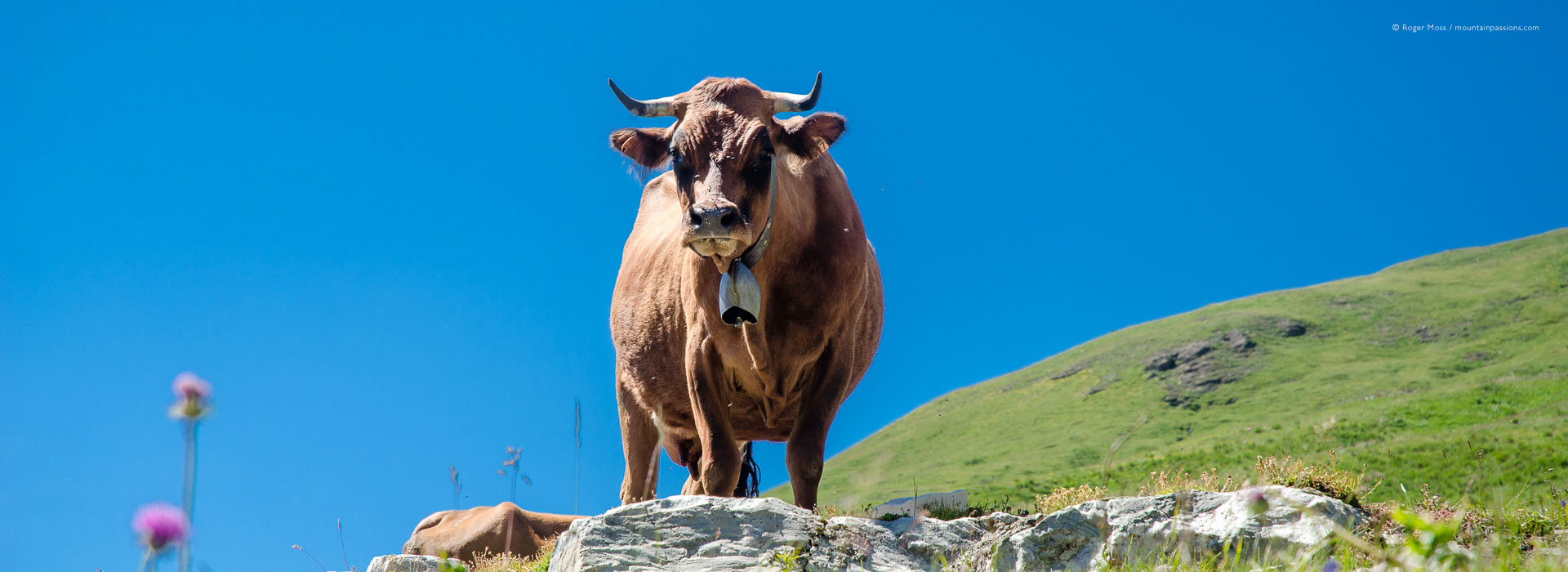
Beaufort Cheese
The highly prized Beaufort Chalet d’Alpage
Unless you’re a keen skier the Beaufortain may not sound instantly familiar, but this tiny area of Savoie, tucked away in peaceful deep valley between Albertville and Mont-Blanc, is without doubt one of the most beautiful corners of France. It’s hardly the kind of place that you’ll stumble upon by chance unless, like me, you decide to follow the legendary Route des Grandes Alpes, or happen to be on a quest for one particular Alpine delicacy. Beaufort-sur-Doron is the spiritual home of Beaufort cheese, but feels more like a village, with a resident population roughly equal to that of the dairy cattle who graze the surrounding pastures.
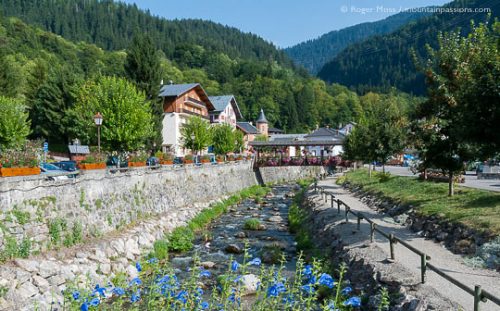
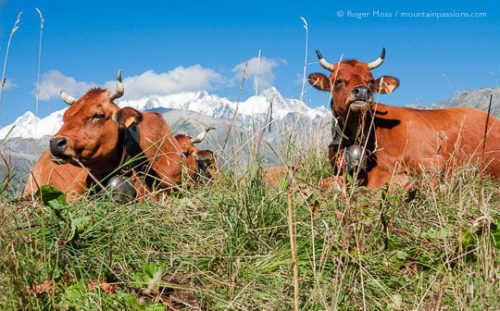
A taste for the good things
Today Beaufort enjoys something approaching global celebrity among lovers of the nutty, Gruyère-style cheese which in 1968 received the coveted AOC (Apellation d’Origine Controlée) status. AOC accreditation assures the quality and authenticity of the product, as well as its place of origin – if the label says ‘Beaufort’ then buyers can be assured that it can only have come from right here in the very heart of the Beaufortain. Most of the annual output of Beaufort cheese is produced and matured (‘affiné’) using traditional methods in Beaufort-sur-Doron’s imposing Laiterie Co-Operative, which represents around 130 local dairy farmers and creates a range of cheeses (also available for visitors to purchase).
Changing with the seasons
The most demanding connoisseurs, however, prize the complex flavours of cheeses created on the mountains themselves by a handful of artisan producers. Cheeses produced between June and October in the mid-mountain pastures (or montagnettes) qualify for the official title of ‘Beaufort Alpage d’Eté’, the discernable variations in their flavours being due to the herbs and wildflowers flourishing briefly among the grass on which the cattle graze. Most highly-prized of all is ‘Beaufort Chalet d’Alpage’, produced in often remote settings above 1500m altitude. The most celebrated artisan producer of Beaufort cheese is Jean-Pierre Blanc, who was awarded a Gold Medal in Paris for his lovingly-crafted ‘Beaufort Chalet d’Alpage’.
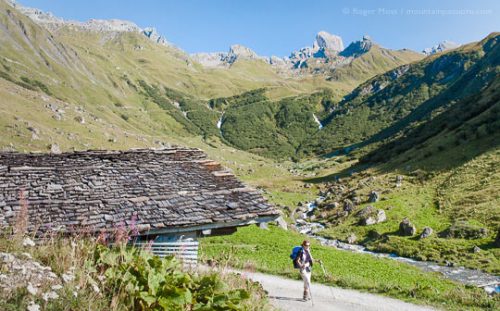
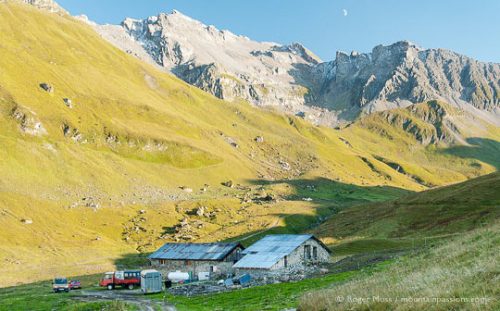
The quest for l’authentique…
My return to the Beaufortain has been carefully timed in late-August to allow me to visit Jean-Pierre at work in the very highest of his mountain chalets – Conchette, at the head of the tiny Vallée de Treicol (alt. 2100m). So remote is the setting that simply finding him will be a something of a challenge.
The adventure begins with a steady climb from the village of Arêches, past the cluster of large mountain chalets which alone constitute the tiny hamlet of Boudin, en-route to the Col du Pré (1703m). Beyond the Col the road descends to the southern shores of the vast turquoise-blue Lac de Roselend before eventually joining the main route from Beaufort for the rugged climb to the spectacular Cormet de Roselend.
The track less travelled…
My journey, though, takes me just beyond the lake onto an inconspicuous unsurfaced track. Before long I cross the first of a series of mountain streams and arrive at Treicol, a group of ancient chalets in a hauntingly wild and beautiful setting. From here the track (a deservedly popular route for walkers) becomes impassible for vehicles with low ground-clearance. It’s also the sole means of access for anyone planning on visiting M Blanc, so I press on, climbing through difficult, uneven terrain for twenty minutes or so. Eventually a rugged-looking stone outline comes into view, set wisely in a sheltered dip in the landscape.
By now the afternoon sun is low and there’s a gnawing chill in the lengthening shadows, but for now there’s no turning back.
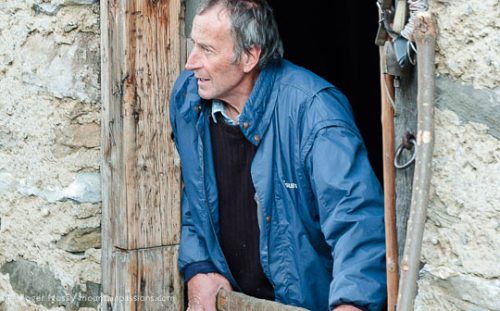
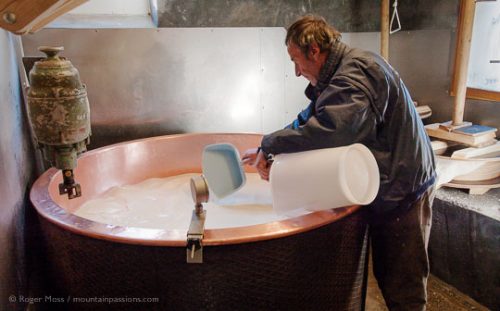
The life of an Alpagist
Jean-Pierre Blanc is a true Alpagist, in the sense that he continues to follow the age-old pattern of working established by his forebears centuries ago. In winter the climate at high altitudes is understandably harsh, so until the snow has melted and the grass reappears the cattle are kept safe and snug in barns on the family farm down on the sheltered floor of the valley. Cheeses produced during this period (typically between November and May) are simply termed ‘Beaufort’. When the springtime thaw begins the cattle are herded to pastures some way up the valley sides where they can enjoy the fresh spring grass (the fertile seasonal grazing areas being known as ‘Alpages’).
Jean-Pierre accompanies his herd, or ‘troupeau’, and from now until the autumn he will live and continue making his cheeses in a succession of robust chalet-style stone buildings owned by generations of his family.
As the snow-line continues to retreat his cattle will follow the fresh new grazing ever higher up the mountainside, and Jean-Pierre will transfer to his next chalet, perpetuating the old tradition of ‘la transhumance’ which is still common in many mountain areas, including the Alps and Pyrénées.
Welcome to Conchette
Jean-Pierre has been expecting me, and greets me with a firm handshake, an easy smile as we step into his mountain refuge. Inside, as befits a living and a working space, things are every bit as basic as I’d imagined when I’d first caught distant sight of the modest stone building. Jean-Pierre is well used to the rigours of true mountain living, and in any case has little time to enjoy the luxuries of a modern lifestyle, as I’m about to discover. First, though, we take advantage of a moment of calm and seat ourselves around a small pine table to enjoy a warming coffee and sample his renowned cheese. The intense flavour is unlike anything I’ve tasted, and I find it hard to believe that it was produced in this wild, remote setting.
“The character of the cheeses is down to what the cows graze on,” explains Jean-Pierre. “Different grasses, wildflowers, exposure to sun and winds – even the soil itself, all add complexity to the flavours of the cheese”.
Jean-Pierre’s 125-strong herd are a mix of the Tarine and Abondance, hardy local breeds. They’re milked twice a day at a nearby mobile milking parlour, the churns of milk then transported to Jean-Pierre’s chalet where he and his two assistants, one a trainee, start their well-rehearsed routine.
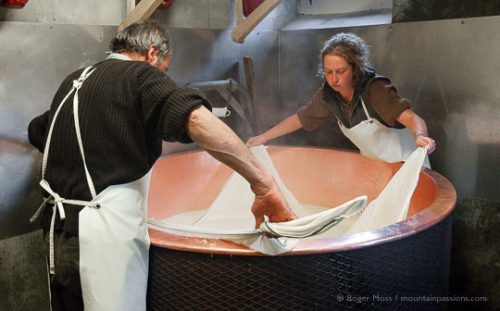
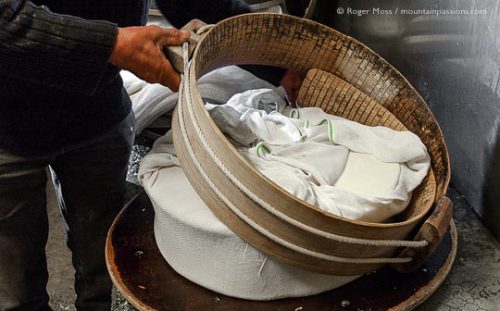
The work begins
First the milk is poured into a vast copper cauldron or chaudron capable of holding around three thousand litres and heated to 33ºC by means a simple ring-shaped burner connected to a large gas cylinder. After filtering and further gentle heating, the milk receives a small amount of natural calf-rennet, and the action of the enzymes triggers a process of coagulation. After about thirty minutes the resulting curds are sliced into small pieces, to eliminate much of the water, using a multi-wire cutter known as la tranche-caillé. The cauldron is then heated to 52ºC, while the contents are stirred continuously. “The important thing is to maintain the temperature – I keep checking the texture by hand for the curds gradually dry out until eventually I can feel the texture I’m looking for. It’s something you learn by experience.”
During this crucial stage (known as brassage sur le feu) Jean-Pierre checks both texture and colour repeatedly until he’s satisfied that the precise moment has come for the heating to stop and the ‘cooked’ cheese removed for pressing.
Doing so is a delicate exercise requiring two people, who pass a muslin cloth supported by a pliable wooden hoop beneath the heavy cheese mixture, to scoop up the contents. This is then hoisted on a pulley to allow the liquid to drain through the muslin, after which the remaining cheese solids are ready to be placed, still in the muslin, into timber moulds, pressed under heavy weights and allowed to solidify. The process continues until all the solids have been removed, and between six and eight of the distinctive, convex-sided cheeses or tommes have been produced.
The work isn’t over yet, however. The remaining liquid is poured into milk churns (to be fed to the appreciative pigs which Jean-Pierre rears), the copper cauldron scrupulously cleaned and the muslin sheets washed and hung out to dry. Once the cheeses have hardened they can be removed from the moulds and carried out to a nearby stone building where the maturing stage or afinage can commence. It’s physically demanding work, not least since the cheeses can weigh up to 70kg, but Jean-Pierre is well accustomed to carrying his precious creations.
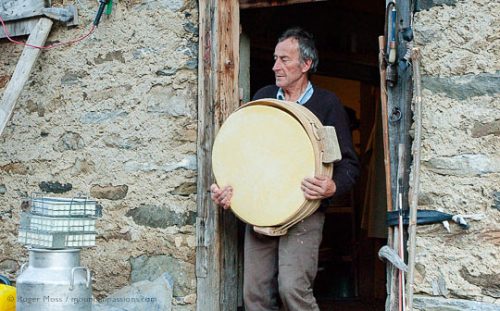
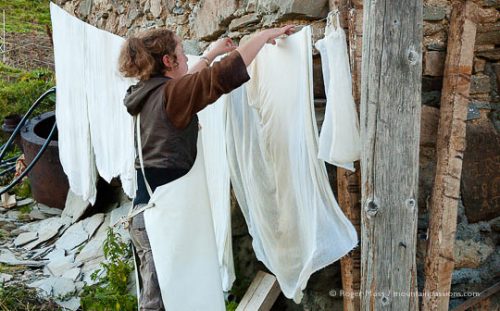
The chill of night returns
By now the sun has disappeared, an almost-full moon is hanging in the deepening dusk and temperatures are falling fast. It’s a long, long way back down to the valley, so I say goodbye to Jean-Pierre, and leave him to enjoy the few hours until the next cheese-making begins again in the early hours of the morning.
Each summer he makes around 350 cheeses, and the work is relentless, for surprisingly little has changed since his grandfather’s day. .
Parting thoughts
Mobile milking parlours, moved by tractors and powered by generators, have replaced hand-milking and gas has replaced wood fires, but the process and the toughness of the work are the same. The potential rewards, though, are far greater now. Beaufort Chalet d’Alpage cheese sells for a premium price – and Jean-Pierre can take pride in the knowledge that his name is now revered by countless cheese-lovers throughout the world who appreciate the Prince de Gruyères. 
Recipes
Tarte au Beaufort
This is a classic Beaufort cheese recipe, a deliciously rich cheese tart with a melt-in- the-mouth buttery pastry. Serve with a green salad and a glass of dry white Vin de Savoie for a perfect light lunch.
Ingredients
250g plain flour
125g butter
3/4 glass of water
Salt
Filling:
100g Beaufort, grated
200ml crème fraîche
1 glass of milk
3 eggs
Nutmeg
Salt, pepper
Method
Sieve the flour into a large bowl, add a pinch of salt. Cut the butter into small pieces and add to the flour. Rub together with your fingertips until the mixture resembles fine breadcrumbs. Add a dessert spoon of water at a time, kneading the mixture until it comes together in a soft dough. Alternatively, put the dry ingredients into a food processor, whiz to breadcrumbs then add two or three dessert spoons of cold water until it forms a ball of dough. Wrap in cling film and refrigerate while preparing the filling.
Preheat the oven to 200°C.
In a bowl, whisk the crème fraîche with the eggs and milk. Season with salt and pepper, grate a little nutmeg, add the grated Beaufort and mix well.
Roll out the pastry dough and line a buttered flan tin – one with a removable base is easiest. Prick the bottom with a fork. Pour in the filling and put in a hot oven for 30 – 35 minutes.
Remove the flan from the tin and serve hot.
Soufflé au Beaufort
Beaufort cheese makes a beautifully tasty soufflé. You can vary the recipe by adding girolle mushrooms or steamed broccoli to the sauce before folding in the egg whites.
Ingredients
200g Beaufort cheese (grated)
50g butter
50g flour
40cl milk
4 eggs
Salt, pepper
Freshly grated nutmeg
Method
Preheat the oven to 220°C (200°C fan oven). Prepare a soufflé dish by greasing with butter then lightly flouring the inside.
Prepare a Béchamel sauce: melt the butter in a saucepan, add the flour, salt, pepper and nutmeg. Beat the mixture together to form a roux then gradually add the milk.
Stir constantly over a low heat until you have a smooth sauce. Mix in the grated cheese and remove from the heat. Separate the eggs and put the whites into a clean bowl. Add the yolks to the sauce and mix well.
Whisk the egg whites until they are stiff. Fold them gently into the sauce, keeping in as much air as possible.
Pour the mixture into the soufflé dish and cook for 30 minutes (don’t open the oven door during cooking or the soufflé will drop). Serve immediately.
